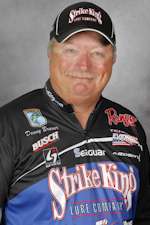In the last lesson we talked about the early fall and the need for anglers to move towards the flat side of the lake or into the creeks, cuts and backwater areas. This time we’ll concentrate on finding the specific spots within those areas.
Before we get started, though, we need to think about what fall is all about. It’s a time when the fishing is almost totally dependent upon what the forage is doing, and that forage is almost always shad or some other type of baitfish. Crayfish are largely out of the picture. And fall is the time of the year when local weather conditions are very important.
Late September and early October can be brutally cold or it can be warm and sunny. It just depends upon what part of the country you’re in and what’s happening with the weather. It’s also a time when cold fronts don’t necessarily have a negative effect on the bite. In fact, sometimes they bite better during a cold snap. You have to consider local conditions before you start your fishing.
In general I’d say you should be looking for isolated pieces of cover right now. In my part of the country (Texas) isolated wood seems to be the thing that attracts them the most. Single stickups, laydowns and stumps are prime holding areas and should be your prime targets. That may not be the case in your lake, however.
You have to look around and see what’s available. That’s what we do as professional anglers. It’s why we find them all over the country. When we get to a new body of water, the first thing we do is look to see what’s there. You should do the same thing. Imagine you’re a bass and think about where you’d be, what you’d gravitate towards and what you’d be doing. Then start fishing. Eliminate as much water as possible before you pick up your rod and reel.
Don’t get too wrapped up with what part of the country you’re fishing in. It’s not about that. It’s about the cover options that are available to the fish in the body of water you’re fishing. The most important thing in the fall is where the forage is located. Fall forage is not hard to find. You can see most of it right on top. Take the time to do that.
Frankly, my primary pattern at this time of the year doesn’t always start with a jig, although it plays a primary part in my approach. I frequently start by throwing a Strike King Series 1.5 square bill crankbait or a Premier Plus Spinnerbait and then following it up by flipping or pitching a jig.
One thing I want to say is that you shouldn’t be afraid to swim your jig. We have a tendency to think of flipping and pitching a jig as a vertical presentation. At this time of the year you might do better swimming it back past the target, especially if you’re dealing with a nasty cold front and the fish don’t want to come off the cover. (Not coming off the cover isn’t the same thing as shutting down. They’ll still bite.)
My color choices are pretty simple at this time of the year. The fish are keying on the forage so I do the best I can to match the color of whatever they’re feeding on. This is the time of the year when I almost always flip or pitch a white jig. It makes a pretty good imitation of whatever’s out there. I like the Strike King Denny Brauer Premier Pro-Model in 1/4- or 3/8-ounce for this type of fishing.
I use my standard flipping and pitching tackle with heavy line. Don’t think that just because you’re swimming your jig you can get away with lighter line, because you can’t. You’re still trying to land an angry bass around heavy cover. You should be prepared. My choice is 25-pound-test Seaguar Tatsu Fluorocarbon.
Next time we’ll talk about how to find them as winter starts to set in and the water turns colder.





